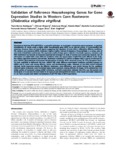Por favor, use este identificador para citar o enlazar este ítem:
http://www.alice.cnptia.embrapa.br/alice/handle/doc/999434Registro completo de metadatos
| Campo DC | Valor | Lengua/Idioma |
|---|---|---|
| dc.contributor.author | RODRIGUES, T. B. | pt_BR |
| dc.contributor.author | KHAJURIA, C. | pt_BR |
| dc.contributor.author | WANG, H. | pt_BR |
| dc.contributor.author | MATZ, N. | pt_BR |
| dc.contributor.author | CARDOSO, D. C. | pt_BR |
| dc.contributor.author | VALICENTE, F. H. | pt_BR |
| dc.contributor.author | ZHOU, X. | pt_BR |
| dc.contributor.author | SIEGFRIED, B. | pt_BR |
| dc.date.accessioned | 2014-11-07T11:11:11Z | pt_BR |
| dc.date.available | 2014-11-07T11:11:11Z | pt_BR |
| dc.date.created | 2014-11-07 | pt_BR |
| dc.date.issued | 2014 | pt_BR |
| dc.identifier.citation | Plos One, San Francisco,v. 9, n. 10, p. 1-8, Oct. 2014. | pt_BR |
| dc.identifier.uri | http://www.alice.cnptia.embrapa.br/alice/handle/doc/999434 | pt_BR |
| dc.description | Quantitative Real-time PCR (qRT-PCR) is a powerful technique to investigate comparative gene expression. In general, normalization of results using a highly stable housekeeping gene (HKG) as an internal control is recommended and necessary. However, there are several reports suggesting that regulation of some HKGs is affected by different conditions. The western corn rootworm (WCR), Diabrotica virgifera virgifera LeConte (Coleoptera: Chrysomelidae), is a serious pest of corn in the United States and Europe. The expression profile of target genes related to insecticide exposure, resistance, and RNA interference has become an important experimental technique for study of western corn rootworms; however, lack of information on reliable HKGs under different conditions makes the interpretation of qRT-PCR results difficult. In this study, four distinct algorithms (Genorm, NormFinder, BestKeeper and delta-CT) and five candidate HKGs to genes of reference (b-actin; GAPDH, glyceraldehyde 3-phosphate dehydrogenase; b-tubulin; RPS9, ribosomal protein S9; EF1a, elongation factor-1a) were evaluated to determine the most reliable HKG under different experimental conditions including exposure to dsRNA and Bt toxins and among different tissues and developmental stages. Although all the HKGs tested exhibited relatively stable expression among the different treatments, some differences were noted. Among the five candidate reference genes evaluated, b-actin exhibited highly stable expression among different life stages. RPS9 exhibited the most similar pattern of expression among dsRNA treatments, and both experiments indicated that EF1a was the second most stable gene. EF1a was also the most stable for Bt exposure and among different tissues. These results will enable researchers to use more accurate and reliable normalization of qRT-PCR data in WCR experiments. | pt_BR |
| dc.language.iso | eng | eng |
| dc.rights | openAccess | eng |
| dc.title | Validation of reference housekeeping genes for gene expression studies in western corn rootworm (Diabrotica virgifera virgifera). | pt_BR |
| dc.type | Artigo de periódico | pt_BR |
| dc.date.updated | 2017-05-23T11:11:11Z | pt_BR |
| dc.subject.thesagro | Gene | pt_BR |
| dc.subject.thesagro | Lagarta | pt_BR |
| dc.subject.thesagro | Genética | pt_BR |
| dc.subject.thesagro | Praga de planta | pt_BR |
| dc.subject.nalthesaurus | Plant pests | pt_BR |
| riaa.ainfo.id | 999434 | pt_BR |
| riaa.ainfo.lastupdate | 2017-05-23 | pt_BR |
| dc.identifier.doi | 10.1371/journal.pone.0109825 | pt_BR |
| dc.contributor.institution | FERNANDO HERCOS VALICENTE, CNPMS. | pt_BR |
| Aparece en las colecciones: | Artigo em periódico indexado (CNPMS)  | |
Ficheros en este ítem:
| Fichero | Descripción | Tamaño | Formato | |
|---|---|---|---|---|
| Validationreference.pdf | 360,72 kB | Adobe PDF |  Visualizar/Abrir |









